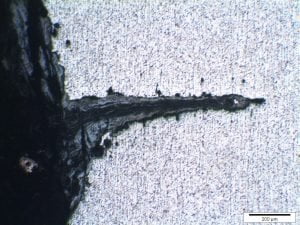This month we continue our #epicfail series on failure mechanisms looking at the impact of corrosive environments on fatigue failure mechanisms known as corrosion fatigue.
Corrosion fatigue is the generation of cracks due to the combined effects of cyclic stresses and corrosion. Critically, unlike a simple fatigue failure mechanism, when corrosive fatigue takes place the fatigue limit (the maximum stress below which a metal can endure an infinite number of stress cycles ) does not exist. Because of the absence of this fatigue limit, the risk of unexpected or premature failure is increased.
Therefore, if a corrosive environment is not taken into consideration at the design stage or is an unknown factor, this can lead to premature catastrophic failure. For example, in 2013, during take-off, an aircraft engine experienced a flash, smoke and loss of power which was the result of a turbine failure due to corrosion fatigue. Luckily the crew were able to perform an emergency stop and taxi the aircraft clear of the runway using the second engine for power. There were no injuries.
At a refinery in Michigan in 2010, a segment of a 30” pipeline ruptured during a planned shutdown and was not discovered for 17 hours. This resulted in a leak of 843,444 gallons of crude oil to the surrounding wetlands. Clean up costs exceeded 767 million dollars. There were no fatalities, but 320 people had symptoms that were consistent with exposure to crude oil. The NTSB determined that the likely cause of failure was attributable to corrosion fatigue.

Figure 1 Corrosion fatigue cracks in a rotating dryer lifter plate
The corrosion fatigue phenomena occurs during the first phase of cyclic stress where cracks are generated in the protective scale, which exposes the metal surface to the environment. The exposed metal surface at the root of the crack oxidises, forming a notch in the metal surface. During the next cycle, the oxide will tend to crack along this notch, causing it to deepen. As this cyclic process continues, a wedged-shaped transversal crack propagates through the tube wall. An oxide wedge forms since the volume occupied by the oxide is greater than the volume of metal from which it forms. The wedge adds stress to the crack tip and prevents the crack from closing. Corrosion fatigue cracks are typically straight, unbranched, wedge-shaped (see Figure 2) and are frequently observed in parallel families (see Figure 1). They may be oriented longitudinally or transversely or skewed, depending on the orientation of the maximum cyclic stress.

Figure 2 Corrosion fatigue crack
Corrosion fatigue can be prevented by reducing or eliminating cyclic stresses such as vibrations, thermal expansion and contraction and flow-induced vibration. Furthermore, the mechanism can be prevented by controlling the corrosion factor; altering the environment, using a more corrosion resistant material or applying a corrosion protection system are examples of how corrosion can be eliminated.
Would you like to know more about our Failure Analysis services? Contact us today to find out more!